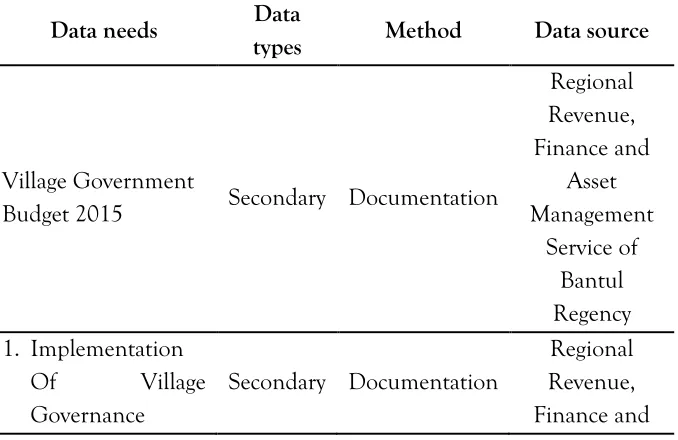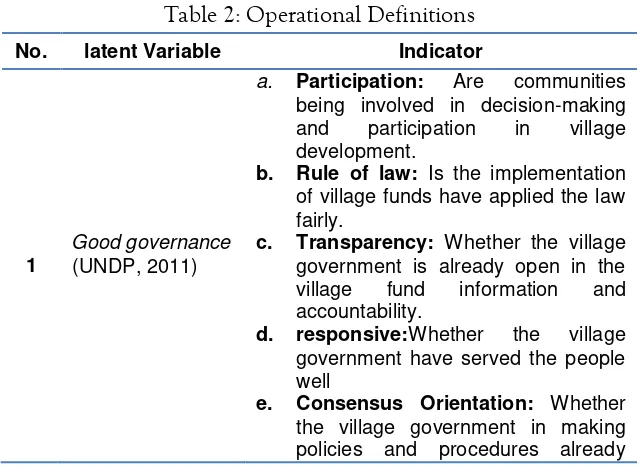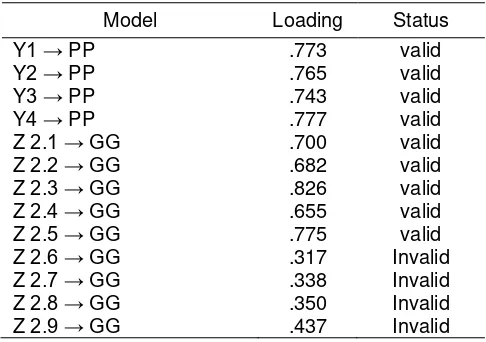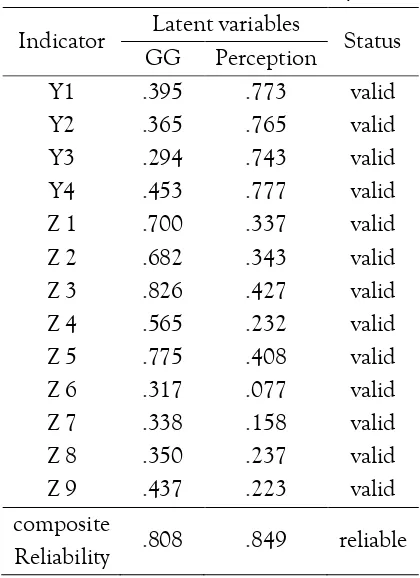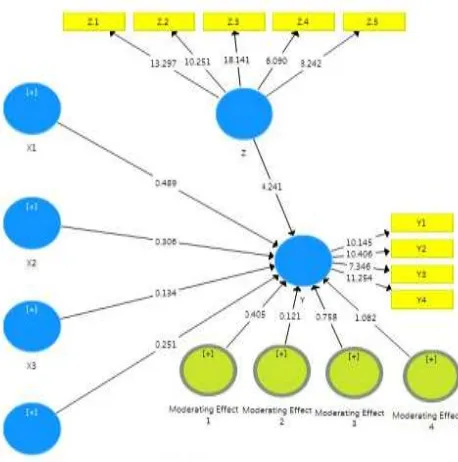Gendro Wiyono1, Fanda Susilawati2
1Faculty Of Economics University Sarjanawiyata Tamansiswa Yogyakarta 2 Regional Revenue, Finance and Asset Management Service of Bantul Regency Email: 1[email protected]; 2[email protected]
212
ABSTRAK Penelitian ini bertujuan untuk mengetahui persepsi masyarakat terhadap implementasi Alokasi Dana Desa yang diperuntukkan bagi Penyelenggaraan Pemerintahan Desa, Pembangunan Desa, Pemberdayaan Masyarakat, dan Kegiatan Kemasyarakatan, dengan pengaruh moderasi good governance. Tujuan alokasi dana desa pada prinsipnya untuk meningkatkan kesejahteraan dan pemerataan pembangunan desa guna mengatasi kesenjangan pembangunan antar desa serta memperkuat masyarakat desa sebagai subjek dari pembangunan. Hal ini sesuai dengan substansi dari Undang-Undang Desa No 6/2014 untuk memberikan otonomi yang lebih besar kepada desa agar dapat mandiri. Saat ini masih banyak pihak yang tidak memahami terhadap penggunaan anggaran dana desa. Perlu ada media yang tepat dan mudah dipahami agar masyarakat bisa melihat dan mengetahui apa yang telah dilakukan pemerintah desa dalam penggunaan anggaran desa. Penelitian ini menggunakan data sekunder yang dikumpulkan dari administrasi desa, sedangkan data primer dikumpulkan dari masyarakat desa Kabupaten Bantul. Alat analisis data yang digunakan StructuralEquation Modeling berbasis variance dengan bantuan
software SmartPLS. Hasil penelitian menunjukkan bahwa
pelaksanaan alokasi dana desa secara simultan untuk semua program memiliki berpengaruh positif dan signifikan terhadap persepsi masyarakat desa, sedangkan program secara parsial untuk masing-masing pedanaan tidak berpengaruh signifikan. Tata kelola yang baik sebagai variabel independen berpengaruh secara signifikan terhadap persepsi masyarakat desa, tetapi peran Tata Kelola sebagai moderasi pelaksanaan setiap program pendanaan secara parsial tidak berpengaruh secara signifikan terhadap persepsi masyarakat.
INTRODUCTION
213
the transfer of authority of the central government to theautonomous regions to regulate and manage the affairs of government within the system of the Unitary State of the Republic of Indonesia. Theoretically, decentralization is expected to generate two tangible benefits: first, encouraging increased participation, initiative and creativity of the community in development, and encouraging equitable distribution of development outcomes across the region by utilizing resources and potentials available in local communities; second, able to improve the allocation of productive resources through shifting the role of public decision-making to the level of village governance (Mardiasmo: 2007, Kaho: 2010).
The purpose of the Village Fund allocation is principally to improve the welfare and equity of village development through improving public services in the village, promoting the village economy, addressing the inter-village development gap and strengthening the village community as the subject of development. This is in accordance with the substance of Village Law No. 6/2014 to grant greater autonomy to the village in order to become
self-reliant. Law no. 6/2014 states that the village is a legal community
214
balance funds received by the regency/municipalities for the village is at least 10% proportionally in the form of Village Fund Allocation. In order to improve the service and welfare of the community, the village has the right to obtain the share of local taxes and levies of regency/municipalities, as well as part of the central and regional financial balancing funds received by the regency. The acquisition of the village finance portion of the regency/municipalities hereinafter referred to as the village fund distributed through the village cash (Halim: 2012, Mardiasmo: 2007). Allocation of village funds is a manifestation of the fulfillment of the right of the village to organize its autonomy to grow and develop following the growth of the village itself based on diversity, participation, indigenous autonomy, democratization and community empowerment. The village fund is the allocation of funds to the village by calculation of the balancing funds received by the regency by 10% after deducting the Special Allocation Fund.215
community; (7).Encouraging the improvement of self-help andcommunity mutual cooperation; and (8).Increase the income of villages and villagers through village-owned enterprises. According to Hardi and Warsono (2014), the role of local government to realize the strategic autonomy of the village, both the original autonomy of the villages themselves and gained autonomy as a consequence of the decentralization principle. Village autonomy is native not a gift from the government. Instead the government is obliged to respect the customary autonomy of the village. Therefore, village funds should be arranged to the needs of the village community (Taufik: 2015).
The management of village funds in Bantul Regency has not been optimal yet and still faces obstacles that are not yet all mapped and resolved. The existing village government in Bantul regency, some have not developed and utilize the Village fund allocation in accordance with the principles of good government expected by the community. That is, in the implementation of village funds required training that gives the ability of the village administration to perform well and obey the principle. Indications of problems that arise include: (1).The distribution of the Village Fund still does not meet the operational standards and the needs of the village community, (2).The preparation of the Revenue and Expenditure Budget of the Village has not followed the process and stages as it should, (3).Proportion between unfair operational expenditures and development expenditures, (5).Financial Delivery Letters are often late.
LITERATURE REVIEW Village Fund
216
Nyimas: 2016). The presence of an independently administered village fund policy has a positive impact on village government. The presence of the village funds also gives the village government the freedom, development and social autonomy (Muhamad et al: 2017, Rasmah :2015, Luke and Ornsiri: 2009). In line with previous research, Fauzi et al (2013), Tjilen et al: (2016), asserted that village funds have the effect of: (1).Increasing the delivery of government services in implementing development; (2).Improving village institutions in the planning, implementation and control of development and community participation; (3).Increase the income, employment and opportunities of village communities in the framework of socio-economic development of the community; (4).Encourage community participation with non-government.217
Good governanceGood governance demonstrates a process whereby people can manage their economies, institutions and social and political resources not only for development, but also to create cohesion, integration, and for the welfare of the people. The ability of the state to achieve its goals depends largely on the quality of governance and interaction with the private and public sectors (Thoha: 2017). Good Governance does not merely involve the government and state, but also the role of various actors outside government and state so that the parties involved are also very wide (Dayanandan: 2013, Young et al.: 2011). In the governance management structure, there are three pillars of governance, namely: government, private sector, and society, so that the mechanism of management of economic and social resources involving the influence of state and non-government sectors in a collective activity (Santosa: 2008).
218
regulations and empower the community and village government to be more familiar with the role and function. According to Sanusi (2014), village funds have implications for encouraging change or improving village development. Although the implementation has not been effective yet the management has shown a significant change to the welfare of the community. Although in the process faced with administrative problems, but the accumulative management of the allocation of village funds reached the target is very clear that can improve and improve the village development. However, the implementation still faces problems related to the disbursement of funds that are not always synchronized with the planned activities caused by the lack of funds and the limited skilled and experienced personnel, as well as the mentality of village officials who lack discipline in working.219
Continue the explanation above, indicator of good governanceaccording to UNDP (2011) as follows: (1).Participation: every citizen has a voice in decision making, either directly or intermediation legitimacy institution represents its importance. Such participation is built on the basis of the legitimacy of association and of speaking and participating constructively. (2).Rule of law: the legal framework should be fair and undertaken indiscriminately, especially the law for human rights. (3).Transparency: transparency is built on the validity of information flows. Processes, institutions and information that are directly acceptable to those in need. (4).Responsive: Institutions and processes should serve every stakeholder. (5).Consensus Orientation: good governance mediates different interests to get the best option for broader interests, both in procedural policy. (6).Equity; All citizens, both men and women have the opportunity to improve and maintain their welfare. (7).Effectiveness and effeciency: processes and institutions produce according to what has been outlined by using the best available resources. (8).Accountability: decision-makers in government, the private sector and society are accountable to the public and stakeholder institutions. (9).Strategic vision: leaders and the public should have good governance and development perspectives that are broad and far ahead in line with what is required for development. Implementation of all good governance indicators, required as a requirement for the creation of good governance and clean governance. In implementing the indicators above, then one of the necessary in order to realize good governance is the creativity of leaders in carrying out their functions or roles, through a democratic leadership pattern that always creates synergies among various elements of development optimally.
Perception
220
governments empower villagers by: (1).Applying the results of science development knowledge and technology, appropriate technology; (2).New findings for economic and agricultural progress of rural communities; (3).Improving the quality of government and village communities through education, training; (4).Recognize and enable the existing institutions in the village community. Village community empowerment is implemented with assistance in the planning, implementation and monitoring of village and rural development. That is, the government is obliged to provide guidance to the village in order to empower the village community, management of village funds, so that it can be used properly targeted according to the needs of village development.The guidance of the village community as stated in Government Regulation No. 43/2014 is clarified and affirmed as follows: (1).Government and local government organize the empowerment of rural community with the assistance in stages in accordance with the needs; (2).The technical assistance by the regency/municipal apparatus can be assisted by professional assistants, village community empowerment cadres, or third parties; (3). Sub-District Head or the assistance of village communities. The professional auxiliaries are: (1).The personnel in charge of assisting the village in the administration of the village administration, village cooperation, the development of village-owned enterprises, and the local village-scale development; (2).Technical assistants assigned to assist the implementation of sectoral programs and activities; and (3).Community empowerment experts who are tasked with increasing the capacity of assistants in the implementation of village governance, village development implementation, village community development, and empowerment of rural communities.
221
the community. Perception is one of the important psychologicalaspects for humans in responding to the presence of various aspects and symptoms around it. Perception contains a very broad sense, concerning the internal and external. Experts have given a diverse definition of perception, although in principle it has the same meaning. Perception includes all signals in the nervous system, which are the result of physical or chemical stimulation of the sensory organs. The process of knowing a few things through the five senses. Mahmud (2017) suggests that perception is the ability of the brain in translating the stimulus or the process to translate the stimulus into the human sense device.
222
response to the result of service of village government. Based on the above theoretical explanation, the research model developed as follows.Figure 1: Research Model
223
Village Fund Program has a positive and significant impact on theparticipation level of the villagers. Community participation starts from planning, implementation, to the preservation of the results of village development both in the form of giving advice, assistance of goods, energy, and participate in utilizing the results of development in the village.
From the results of this study, the higher the village funds the greater the influence on the village development. However, the implementation of village funds requires assistance as stipulated in Government Regulation No. 43/2014 that the Government and local governments to organize the empowerment of village communities with assistance in stages in accordance with needs. It is interpreted in this case that with assistance the implementation of village funds will run in accordance with expectations. In order for the village funds to achieve its objectives, it needs to be done with the principle of good governance. According Sadjijono (2007) good governance means the activities of a government agency run on the interests of the people and the norms that apply to realize the ideals of the country. Good governance is a solid and responsible management of development management in line with efficient democratic and market principles, avoiding misallocation of funds, preventing corruption both politically and administratively, exercising budget discipline and creating legal and political frameworks for business growth. Conceptionally, the implementation of good governance in the management and utilization of village funds in accordance with the allocation so as to be able to overcome the problems that exist in the village.
224
goes into the human senses. Bimo (2015) reveals that perception is the process of organizing, interpreting the stimulus received by organisms or individuals so that it becomes something meaningful, and is an integrated activity within the individual. Meanwhile, Robert et al. (2010) states that perception is the process of interpreting information obtained through the system of the human sense device, namely: sensory recording, pattern recognition, and attention. That is, perception is a process that starts from the vision to form a response that occurs in the individual so that the individual is aware of everything in the environment through the senses he has. Thus how the implementation of village funds with the mentoring process based on good governance will shape the perception for the community.Based on the above theories and studies, the hypothesis developed as follows:
H1. The village funds for village administration has a positive and significant impact on public perception.
H2. The village funds for village development has a positive and significant impact on public perception.
H3. The village funds for the community empowerment has a positive and significant impact on public perception.
H4. The village funds for community activities has a positive and significant impact on community perceptions.
H5. Implementation of good governance has a positive and significant impact on public perception.
H6. Simultaneously the use of village funds for: the implementation of village governance, village development, village community empowerment, and community activities have a positive and significant impact on public perception.
225
H8. The implementation of good governance in village development has a positive and significant impact on public perception. H9. Implementation of good governance in the empowerment of
This research is done by quantitative method. The population of the study included the community and village government apparatus.
The unit of analysis of this study are individuals who understand the substance of research obtained as a sample by using purposive sampling technique. By using such techniques it is expected that the data obtained will be relevant to the research problem. Data were collected by documentation method for secondary data, while primary was obtained by using questionnaire.
Table 1: Data, Methods, and Data Sources
Data needs Data
types Method Data source
Village Government
Budget 2015 Secondary Documentation
226
Funding (VGF)This research model uses two latent variables with operational definition as shown in the following table.
.
Table 2: Operational Definitions
No. latent Variable Indicator
1
Good governance
(UNDP, 2011)
a. Participation: Are communities
being involved in decision-making and participation in village development.
b. Rule of law: Is the implementation
of village funds have applied the law fairly.
c. Transparency: Whether the village
government is already open in the village fund information and accountability.
d. responsive:Whether the village
government have served the people well
e. Consensus Orientation: Whether
227
noticed broad interest.f. equity:Whether the village
government had imposed equal rights between men and women.
g. Effectiveness and
efficiency:Whether the village
government has been carrying out rural funds effectively and efficiently.
h. Accountability: Whether the village
government has been using village administration of the village administration already performing well.
b. Is the use of village funds in the implementation of rural development already performing well
c. Is the use of village funds in community empowerment already performing well
d. Is the use of village funds in the Guidance for the village community already performing well
228
RESULTS AND DISCUSSIONThe first phase of the research is a test of the validity and reliability of the indicators that shows how strong the results of the use of theoretical measurements used to define the construct (Hair et al: 2013). The strong correlation between construct and indicator and its relation to other variables is one way to test the validity of constructs, which consists of convergent validity, discriminant validity, and composite reliability. Test results as shown in the table below.
229
Based on table-4 above there is a valid construct due to > .600, butsome are invalid because < .600
Table 5: Discriminant Validity
Indicator Latent variables Status GG Perception
Y1 .395 .773 valid
Y2 .365 .765 valid
Y3 .294 .743 valid
Y4 .453 .777 valid
Z 1 .700 .337 valid
Z 2 .682 .343 valid
Z 3 .826 .427 valid
Z 4 .565 .232 valid
Z 5 .775 .408 valid
Z 6 .317 .077 valid
Z 7 .338 .158 valid
Z 8 .350 .237 valid
Z 9 .437 .223 valid
composite
Reliability .808 .849 reliable
Discriminant validity indicate that all indicators are valid with strong correlation results with the parent construct compared to other constructs. Besides that the test also shows reliable with result of .849 > .700.
Inner Model
230
Figure-2: Model Test Results
The result of the model test, as stated in table-6.
Table 6: Testing Hypotheses
Hypothesis
Original Sample (Coefficient Parameters)
Pvalue Result
H1. The village funds for village administration has a positive and significant impact on public perception.
.099 .646 Rejected
H2. The village funds for village development has a positive and significant impact on public perception.
231
positive and significant impact on community perceptions..063 .799 Rejected
H5. Implementation of good
governance has a positive and significant impact on public perception. community activities have a positive and significant impact on public perception. significant impact on public perception.
-.028 .812 Rejected
H8. The implementation of good
governance in village
development has a positive and significant impact on public perception
232
H9. Implementation of goodgovernance in the
empowerment of village
communities have a positive and significant impact on public perception.
-.286 .057 Rejected
H10. The implementation of good
governance in village
community activities has a positive and significant impact on public perception
.260 .097 Rejected
233
education and the participation of the community in assisting thephysical development of development (Ni Kadek et al: 2015, Nyimas: 2016).
Good governance as an independent variable actually has a significant effect on the perception of the community, but for the implementation of each program partially does not significant effect on community perception. This is in line with the results of observations LAN and BPKP (2000) that from the development that has been running so far, the implementation of good governance in Indonesia has not been fully successful. There is still a lot of cheating and leakage found in the management of budget and accounting (Titiek and Yulianto: 2016). Richardo's (2014) and Hardi and Warsono (2014) results also find the same findings that accountability of village funds to communities has not been good. Meanwhile, Syofian and Tiyas (2014) research concludes the lack of village cooperation on the grounds that lack of coaching and training affects the ability of village government apparatus. The research results of Titiek and Yulianto (2016), and Rani (2015) provide a similar statement that the obstacles to the implementation of good governance of village financial management are due to inadequate human resources in village government.
234
revenue and expenditure budget of the village has not followed the process and stages as it should, (3).Income accounts and wrong account codes, (4).Proportions between uneven operational expenditures and development expenditures, (5).Financial report is often late.The above problems are perceptions that are known and understood by society. According to Hildah and Nyovani (2014) stated that village goverments should understand the factors that influence village development according to the village people's point of view. Therefore it is necessary to know the multidimensionality of development perceived by the community. It requires non-specific and contextual measures to understand and plan policies focused on the anticipated per- sons, needs, and development outcomes based on individual and socio-economic characteristics of rural communities, it should be understood that community perceptions have different responses to village government service outcomes Sitti: 2013).
CONCLUSIONS
235
REFERENCESAhm ad Soleh, Feri Susanto, Reka Susanti. (2017). Persepsi Aparat ur Pemerint ah Desa Terhadap Dana Desa Di Kecamat an Seluma Barat Kabupaten Selum a. Ekombis Review Program Studi Akuntansi Fakultas Ekonomi Universitas Dehasen Bengkulu. Hal. 114-125
Bimo (2015). Pengant ar Psikologi Umum. Yogyakarta: Andi Offset .
Dahyar, Daraba. (2017). Pengaruh Program Dana Desa Terhadap Tingkat Partisipasi M asyarakat Di Kecamat an Galesong Utara Kabupat en Takalar. Sosiohum aniora, Volum e 19 No. 1 M aret 2017 Hal: 52 58 Dana Desa Terhadap Peningkatan Pembangunan Dan Ekonomi Di
Kecamat an Pineleng Kabupat en M inahasa.
Agri-Sosioekonomiunsrat,Issn 1907 4298 ,Volume 13 Nomor 2a, Juli
Helen, Florensi. (2014). Pelaksanaan Kebijakan Alokasi Dana Desa dalam M emberdayakan M asyarakat Desa di Desa Cerme, Kecamatan Grogol, Kabupaten Kediri. Kebijakan dan M anajem en Publik ISSN 2303 - 341X Volume 2, Nom or 1, Januari 2014.
236
Heppy, Purbasari. Bram udya, Wisnu W. Ilham, Adhi P. (2018). Analisis Pengaruh Pendapat an Asli Desa, Dana Desa, Alokasi Dana Desa DanBagi Hasil Pajak Dan Retribusi Terhadap Belanja Desa Bidang Pekerjaan Umum Dan Pertanian (Studi Empiris Di Seluruh Desa Se-Kabupat en Sukoharjo). The 7th
University Research Colloqium 2018 Stikes Pku M uhamm adiyah Surakarta
Hildah, Essendi. Nyovani, M adise. (2014). Factors Influencing Perception Of Developm ent In Rural Kenya: A Struct ural Equat ion M odeling Approach. European Journal of Research in Social Sciences Vol. 2 No. 4, 2014 ISSN 2056-5429.
Kaho, Josef R. (2010). Prospek Otonomi Daerah di Negara Republik Indonesia : Identifikasi Faktor-Faktor yang m empengaruhi Penyelenggaraan
Otonomi Daerah. Jakart a : PT. Rajaw ali Pers.
LAN-BPKP, (2000), Akunt abilitas dan Good Governance, Jakarta:LAN-RI.
M odul 1-5, M odul Sosialisasi Sist em Akunt abilitas Kinerja Inst ansi
Pemerint ah (AKIP), LAN BPKP RI, Jakart a.
Lukas, M enkhoff . Ornsiri, Rungruxsirivorn. (2009). Village Funds and Access to Finance in Rural Thailand. Discussion Paper No. 417.
M ahm ud, Dimyati (2017). Psikologi Pendidikan. Yogyakarta: Widya Ananda M ardiasmo. (2007), Ot onomi Daerah dan M anajemen Keuangan Daerah .
Yogyakarta : Andi Offset
M uhamm ad Eko Atm ojo. Helen Dian Fridayani, Aulia Nur Kasiw i, M ardha Adhi Pratama. (2017). Efektivitas dana desa untuk pengembangan potensi ekonomi berbasis partisipasi m asyarakat di Desa Bangunjiw o.
Jurnal Sosial Politik Humaniora. htt p://journal.umpo.ac.id
/index.php/aristo/ [email protected]. P.126-140.
Ni Kadek Darmiasih. Ni Luh Gd Erni Sulindaw ati. Nyom an Ari Surya Darmaw an. (2015). Analisis M ekanisme Penyaluran Alokasi Dana Desa Pada Pemerint ahan Desa (Studi Kasus Desa Tri Buana, Kec.Sidemen, Kab.Karangasem). e-Journal S1 Ak Universitas Pendidikan Ganesha Jurusan Akunt ansi Program S1 (Volume 1 No: 3 Tahun 2015.
Nyimas Latifah Letty Aziz. (2016). The Village Aut onomy And The Effektiveness Of Village Fund.. Jurnal Penelitian Politik | Volum e 13 No. 2 Desember 2016 | 193 211.
Peraturan Pem erint ah 72 Tahun 2005 tentang Desa
237
Rani Eka Diansari . (2015). Analisa Implement asi Alokasi Dana Desa Kasus Seluruh Desa di Kecamat an Kledung Kabupat en Temanggung. Seminar Nasional Universit as PGRI Yogyakarta 2015.
Rasm ah, Hasm an. (2015). Implement asi Kebijakan Alokasi Dana Desa Di Kecamat an Kinovaro Kabupaten Sigi. e-Jurnal Kat alogis, Volum e 3 Nomor 11, Nopember 2015 hlm 117 ISSN: 2302-2019 Hal. 107-117.
Richardo Juniast er Tampubolon. (2014). Pelaksanaan Prinsip Good Governance Dalam Alokasi Dana Desa Di Desa Teluk Bakau Kecam at an Gunung Kijang Kabupaten Bintan Tahun 2013. Unpublish M anuscript .
Robert L. Solso , Otto H. M aclin , M . Kimberly M aclin S. (2010). Psikologi
Kognitif. Yogyakart a: Erlangga.
Salahudin, Anas. (2016). Filsafat Pendidikan, cet . ke-10. Bandung: Pustaka Setia, 2011
Santosa, Pandji. (2012). Administrasi Publik, Teori dan Aplikasi Good
Governance. Bandung:Refika Adit ama.
Sanusi. DB.Paranoan. Achmad Djumlani. (2014). Im plement asi Kebijakan Alokasi Dana Desa Di Desa Balansiku Kecam at an Sebatik. eJournal Administrative Reform , 2014, 2 (3): 1732-1745 ISSN 2338-7637, ar.mian.fisip-unmul.ac.id.
Sarint an Efratani Dam anik. (2016). Pemberdayaan Desa Unt uk Penguat an Partisipasi M asyarakat Dalam Penyelenggaraan Pemerintahan Desa.
w w w .usi.ac.id/karya ilmiah dosen.
Sitti Rusnani. (2013). Persepsi M asyarakat Tentang Pelayanan Publik Di Kant or Kelurahan Handil Bakti Kecam atan Palaran Kot a Sam arindah.
eJournal Administrasi Negara, 2013 , 1 (2): 365 -379 ISSN
0000-0000, ejournal.an.fisip-unm ul.org.
Syofian dan M .Y. Tiyas Tinov. (2014). Transformasi Pelaksanaan Pemerint ahan Desa. Jurnal Kebijakan Publik, Volume 5, Nomor 1, M aret.
Taufik Kurrohman. (2015). Account ability of planning on village fund allocation in osing com munity in Banyuw angi. Department of
Accounting, University of Jember, Indonesia Int ernational Conference
on Accounting Studies (ICAS) 2015 17-20 August 2015, Johor Bahru, Johor, M alaysia.
238
Titiek Puji Astuti. Yuliant o. (2016). Desa M enyongsong Berlakunya Undang-Undang No. 6 Tahun 2014. Good Governance Pengelolaan Keuangan Berkala Akunt ansi dan Keuangan Indonesia 1 (2016): 1-14.Tjilen, Alexander Phuk. Frans Papilaya and Edi Cahyono. (2016). Implement ation of t he Economic Program Empow erment of Local Com munities in Sot a Dist rict, M erauke Sub District. Review Pub Administration M anag, an open access journal ISSN:
2315-.
Village Law No. 6/2014 (Undang-Undang Nom or 6 Tahun 2014 Tent ang
Desa)
Government Regulation No. 72/2005 on Allocation Village Fund (Undang-Undang Nomor 72 Tahun 2005 Tentang Alokasi Dana Desa)
UNDP. (2011). Governance Principles, Institutional Capacity And Quality. Widodo. (2008), Good Governance Telaah Dari Dimensi Akunt abilitas,
Kontrol Birokrasi Pada Era Desentralisasi Dan Otonomi Daerah,
Surabaya : Insan Cendekia.
Wiyono, Gendro. (2011). M erancang Penelitian Bisnis, Dengan Alat Analisis
SPSS 17.0 & Sm art PLS 2.0. Yogyakarta: UPP STIM YKPN.
Young Sokphea, Sopart h Pongquan. Sophal Ear. (2011). Local Good Governance of Rural Infrastruct ure Development Planning: Case Studies of Com mune Councils in Cambodia. IJERD International Journal of Environmental and Rural Development (2011) 2 1.

